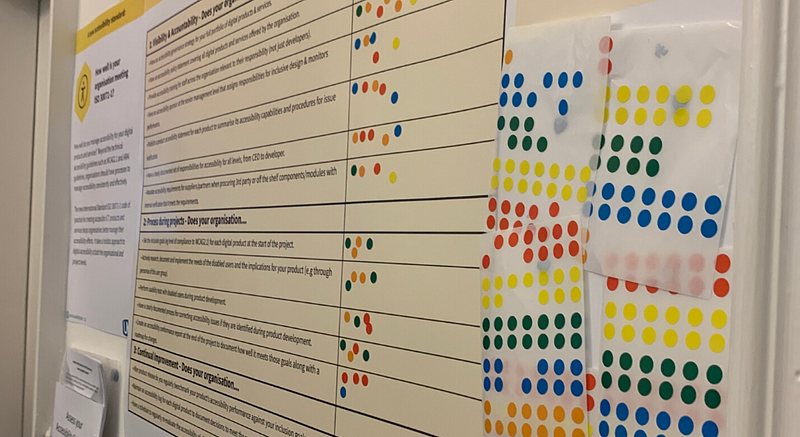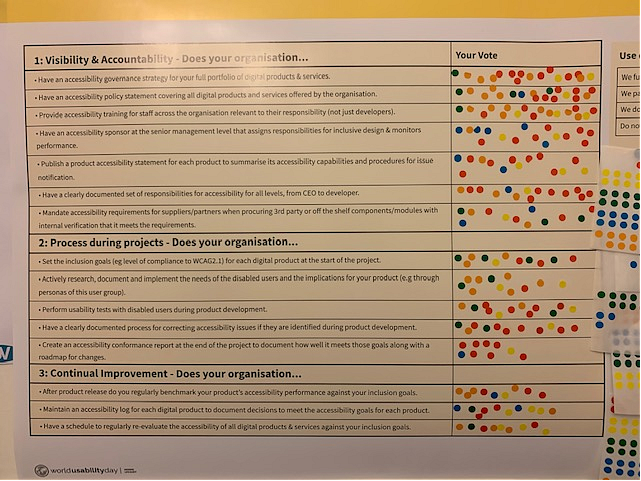Accessibility Management and Strategy Deserves More Focus
11 December 2019 - Chris Rourke

A new accessibility standard
Our World Usability Day poster prompted users to indicate how well they met various best practices for managing digital accessibility and inclusive design. These are not the technical guidelines such as Web Content Accessibility Guidelines (WCAG 2.1) or Accessible Rich Internet Applications (ARIA). Instead they address the strategy and ongoing management of accessibility within an organisation. They include the policies, governance practices and processes that help ensure accessibility is well understood throughout the organisation and consistently implemented (and not just addressed when a specific accessibility issue has arisen).
The reason we focused on managing accessibility is that the international standard ISO 30071: Code of practice for creating accessible ICT products and services was released earlier this year. The standard is available for purchase as are helpful guidance books(this will open in a new window) such as those by Jonathan Hassell, the lead author of the standard.
At User Vision we provide several accessibility services, including technical training for developers, inclusive design awareness workshops for management, technical audits and usability testing with people with disabilities. All of these help to improve inclusive design to create more accessible digital products. However, there is a potential for a company to apply a short-term focus on accessibility for a specific project which then fades, especially when relevant team members leave or move to the next project. Indeed, without a documented policy and consistent process the good work conducted in one part of an organisation does not translate to other areas or new projects. The strategic accessibility governance practices recommended by ISO 30071 aim to minimise this risk through the appropriate multi-level awareness and management practices.
Choosing your accessibility compliance through our poster
A set of 15 recommendations for managing inclusive design were listed, which we classified into three areas:
- Visibility & Accountability of accessibility
- Accessible design process during projects
- Continual Improvement in inclusive design
For each recommendation, participants could rate, to the best of their knowledge, how well their organisation complied by selecting from four levels and applying four different coloured dots:
- Fully comply = green dot
- Partially comply = orange dot
- Don’t comply = red dot
- Not Applicable = blue dot

This was not intended to be solid quantitative research and the number of votes for each recommendation varied slightly. Also, the event attendees may not be fully involved with their organisation’s accessibility efforts. But from the voting results and the discussions with participants during the afternoon, it seems that there is room for improvement in accessibility governance. We have compiled our findings and have summarised the conclusions.
- Visibility and Accountability - This section of questions focused on how much attendees believed their organisations prioritised accessibility. The results for whether of not attendees felt their company ‘have an accessibility governance strategy for their full portfolio of digital products and services’ were notable as the majority believed their company did NOT meet this recommendation. However, the majority of voters did in fact believe that their organisation ‘partially’ provides accessibility training for staff across the organisation relevant to their responsibility.
- Process during projects - This section required attendees to think about accessibility in terms of projects undertaken. More positively, attendees believed their company equally fully or partially met the recommendation to set the inclusion goal (eg level of compliance to WCAG 2.1) for each digital product at the start of the project. However the majority of attendees believed their company failed to perform usability tests during product development, or have a clearly documented process for correcting accessibility issues that are identified. Furthermore most did not create accessibility conformance reports at the end of projects to document how well it meets those goals along with a roadmap for changes.
- Continual Improvement - This section covered the amount of effort put in by companies to ensure they are constantly striving to ensure their process is running as efficiently as it can. Answers for these questions were all answered as ‘partially meet’, and consisted of the following – ‘after product release do you regularly benchmark your product's accessibility performance against your inclusion goals’, ‘maintain an accessibility log for each digital product to document decisions to meet the accessibility goals for each product’ and ‘have a schedule to regularly re-evaluate the accessibility of all digital products & services against your inclusion goals’.
There was only one area for which most people indicated that they fully met the recommendation and this was about setting a target accessibility level at the start of a project. All the rest were skewed toward partially meeting or not meeting the recommendation at all. This was especially the case for the following recommendations :
- Having clearly documented accessibility responsibilities across all levels of the organisation
- Having an accessibility sponsor at senior level in the organisation
- Having a clearly documented process for correcting accessibility issues identified during development
- Creating an accessibility conformance report at the end of a project
Conclusion – Focus needed on accessibility governance and strategy
From the results gathered and the discussions with people at our World Usability Day, it is clear to us that many organisations have little in the way of accessibility strategy or governance. Indeed, many attendees were unaware of this aspect of inclusive design, and instead had assumed the matter focused around the technical guidelines of WCAG 2.1. However, all appreciated the importance of managing accessibility for the long term, noting that without approval and support at the upper levels of the organisation, there is less imperative for internal design and development teams to scrutinise the accessibility of their own work, let alone partner organisations.
We are glad that our informal interactive poster exercise helped to raise awareness of accessibility strategy and governance issues, and perhaps these will be discussed more often as a result. If you have any questions about managing your accessibility, we would love to talk to you about it. Through training, awareness, and policy or practice development, we can help ensure that you consistently deliver inclusive design to all of your digital touchpoints.
You might also be interested in...
When Did You Last Update Your Accessibility Statement?
11 December 2025Your accessibility statement says more about your organisation than you think. Learn why keeping it current matters for trust, compliance, and user experience—and what UK, EU, and US regulations expect.
Read the article: When Did You Last Update Your Accessibility Statement?Making Hospitality Welcoming for All: A Digital Accessibility Guide for Hotels
21 November 2025Hotels have long focused on physical accessibility, but true inclusion extends online. This practical guide explains how to make your hotel website accessible for all guests—meeting global WCAG and EAA standards, expanding your reach, and creating a seamless booking experience for every visitor.
Read the article: Making Hospitality Welcoming for All: A Digital Accessibility Guide for Hotels3 perspectives on how AI is shaping inclusive digital experiences
10 November 2025AI is transforming digital accessibility — empowering disabled users, enhancing how we evaluate digital experiences, and reshaping how inclusive products are designed. This article explores three key perspectives and highlights how AI can support more equitable, human-centred digital experiences when used thoughtfully and collaboratively.
Read the article: 3 perspectives on how AI is shaping inclusive digital experiences